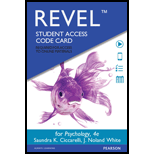
The term “stress” is used to define the emotional, physical, cognitive and behavioral responses originated due to challenging or threatening events. Marriage, car problems and so on are some specific stressors.
Pressure, uncontrollability, frustration, and aggression are some psychological reasons that people find such events stressful. Aggression consists of actions that causes harm and destroy another person due to frustration.
Answer to Problem 10TY
Correct answer:
A person comes home from work angry because of an argument he had with his boss. Subsequently, the person begins yelling at her wife for no apparent reasons. Ultimately, wife of the person finds herself yelling at their youngest child for apparently no good reason other than being frustrated. The wife of that person is displaying displaced aggression. This information is reflected in option “c”. Therefore, option c is correct.
Option c. is given as “displaced aggression”.
Explanation of Solution
Reasons for the correct statement:
Aggression in which one’s frustration is taken out on some less threatening or more available target is termed as displaced aggression. In the given case, wife of the person was frustrated by things that occurred in his office then he yelled at Kina for no reasons. It made wife of the person frustrated and he started to yell at his children. This is due to displaced aggression.
Hence, option c. is correct.
Reasons for the incorrect statements:
Option a. is given as “escape”.
Escape is another reaction of frustration that makes people to leave, drop the school and quit the job or end a relationship. Hence, it is a wrong answer.
Option b. is given as “withdrawal”.
Withdrawal is another reaction of frustration that makes people to leave, drop the school and quit the job or end a relationship, is also known as escape. Hence, it is a wrong answer.
Option d. is given as “projection”.
Projection can be defined as a psychologically mechanism in which, people response or act in order to handle the difficult emotions or feelings. Hence, it is a wrong answer.
Hence, options a., b., and d. are incorrect.
Displaced aggression occurs when one tries to take out their frustration due to other reasons, on someone who is less threatening or easily available to them.
Want to see more full solutions like this?
Chapter 11 Solutions
Psychology, Books a la Carte Edition; REVEL for Psychology
- Summarize key aspects on the buddhism tradition that has impacted your understanding of religious diversity?arrow_forwardwhat important foundational factors and sacred texts and traditions for the buddhism tradition? use 2 scholarly articles properly citedarrow_forwardwhere and how did the buddhist tradition emerge?arrow_forward
- for a drug treatment program what are the prominent theories/models that underlie the service provided. Moral Model, Medical - Disease Model Learning Theory, Psychoanalytic Theory. Ecological Perspective, Family Theory, Bio Psycho Social Theoryarrow_forwardwhat skills or information do you need to improve the quality of your work with Alcohol or drug abuse clients?arrow_forwarddescribe an imaginary/factious treatment agency/program addressing clientele, level of care, curriculum, assessment procedures, treatment plans, case management and counseling issues, staff issues, etcarrow_forward
- Construct an example of a peer evaluation. Instructions: Clarity and coherence of writing Depth of musical analysis Accuracy and relevance of observations Organization and structure of the report Grammar, spelling, and punctuation Originality of workarrow_forwardDraft an example of a peer evaluation. Instructions: Clarity and coherence of writing Depth of musical analysis Accuracy and relevance of observations Organization and structure of the report Grammar, spelling, and punctuation Originality of workarrow_forwardMatch musicians with a style of jazz. Prompts Answers Antonio Carlos Jobim Bossa Nova Tito Puente Latin Jazz Maceo Parker Third Stream Gil Evans Funkarrow_forward
- Write an example of a personal reflection of your course. - What you liked about the course. - What you didn’t like about the course. - Suggestions for improvement. The Reflection Paper should be 1 or 2 pages in length.arrow_forwardHave you experienced a state of flow? If so, please describe what you experienced, and what factors you think contributed to this occurring. If not, discuss what you think might assist you in experiencing flow. Do you believe it is necessary to be in a state of flow to fully engage in creative work; or is it helpful but not strictly necessary? Support your position with your own observationsarrow_forwardThis unit is designed to introduce students to the principles of community psychology and examine local issues through a lens of social determinants of health. Students will explore varieties of community issues such as homelessness, substance abuse, visible and invisible disabilities, and the public health crisis of racism. By analyzing the ways in which SDH intersects with both physical and mental health, both in their own communities and in differing communities, students will understand how social inequities can significantly impact the overall health of a population. Short Description This activity explores how inequality has both physical and psychological impacts on the individual and the community's health. Students will use a step-by-step analysis of SDH around the world. Instructions Using the unit readings, review the Social Determinants of Health: Public Health Agency of Canada. (2020, October 7). Social determinants of health and health and health inequalities. Government…arrow_forward
 Ciccarelli: Psychology_5 (5th Edition)PsychologyISBN:9780134477961Author:Saundra K. Ciccarelli, J. Noland WhitePublisher:PEARSON
Ciccarelli: Psychology_5 (5th Edition)PsychologyISBN:9780134477961Author:Saundra K. Ciccarelli, J. Noland WhitePublisher:PEARSON Cognitive PsychologyPsychologyISBN:9781337408271Author:Goldstein, E. Bruce.Publisher:Cengage Learning,
Cognitive PsychologyPsychologyISBN:9781337408271Author:Goldstein, E. Bruce.Publisher:Cengage Learning, Introduction to Psychology: Gateways to Mind and ...PsychologyISBN:9781337565691Author:Dennis Coon, John O. Mitterer, Tanya S. MartiniPublisher:Cengage Learning
Introduction to Psychology: Gateways to Mind and ...PsychologyISBN:9781337565691Author:Dennis Coon, John O. Mitterer, Tanya S. MartiniPublisher:Cengage Learning Psychology in Your Life (Second Edition)PsychologyISBN:9780393265156Author:Sarah Grison, Michael GazzanigaPublisher:W. W. Norton & Company
Psychology in Your Life (Second Edition)PsychologyISBN:9780393265156Author:Sarah Grison, Michael GazzanigaPublisher:W. W. Norton & Company Cognitive Psychology: Connecting Mind, Research a...PsychologyISBN:9781285763880Author:E. Bruce GoldsteinPublisher:Cengage Learning
Cognitive Psychology: Connecting Mind, Research a...PsychologyISBN:9781285763880Author:E. Bruce GoldsteinPublisher:Cengage Learning Theories of Personality (MindTap Course List)PsychologyISBN:9781305652958Author:Duane P. Schultz, Sydney Ellen SchultzPublisher:Cengage Learning
Theories of Personality (MindTap Course List)PsychologyISBN:9781305652958Author:Duane P. Schultz, Sydney Ellen SchultzPublisher:Cengage Learning





